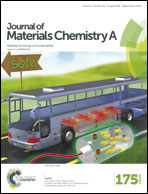Facile low-temperature synthesis of hematite quantum dots anchored on a three-dimensional ultra-porous graphene-like framework as advanced anode materials for asymmetric supercapacitors†
Abstract
A composite consisting of well-dispersed and ultrafine hematite quantum-dots (∼2.7 nm) anchored on a three-dimensional ultra-porous graphene-like framework (denoted as Fe2O3-QDs–3D GF) has been designed by a facile and scalable strategy. In the composite, the ultra-porous 3D GF with high conductivity and high surface area was used as a conductive matrix with surface defective sites for the controllable growth of uniformly dispersed, ultra-small Fe2O3-QDs. The graphene framework can tightly hold a great amount of Fe2O3-QDs, thereby ensuring high utilization of active materials and the required conductivity to individual Fe2O3-QDs. The ultra-small-sized Fe2O3-QDs anchored on the 3D GF can endow the composite with a superior high surface area and enough active sites for electrochemical reactions, thus giving the composite a large specific capacitance. As expected, the as-prepared Fe2O3-QDs–3D GF electrode exhibited a high specific capacitance of 945 F g−1 at 1.0 A g−1 in a three-electrode system in 2.0 mol L−1 KOH aqueous solution. In addition, high-performance asymmetric supercapacitors have been fabricated with Fe2O3-QDs–3D GF as the anode and 3D hierarchical porous graphene (HPG) as the cathode, and they showed a very high energy density of 77.7 W h kg−1 at a power density of 0.40 kW kg−1 and maximum power density of 492.3 kW kg−1, as well as excellent cycling stability.


 Please wait while we load your content...
Please wait while we load your content...